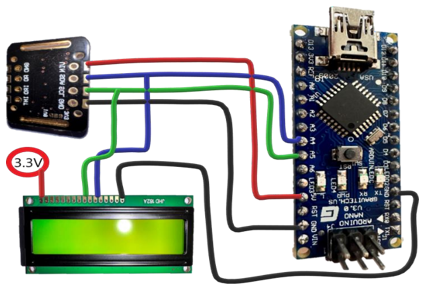Design and Demonstration of Arduino based Low Cost Pulse Oximeter
Main Article Content
Abstract
One of the main reasons for the pushback of the pandemic in India was the awareness that developed in people during the crisis. The adapting mindset of the Indian populace helped turn the tides. The Pulse Oximeter proved to be an important tool that helped in identifying the affected, to get timely healthcare. A very simple information was shared among people that the BPM (heart rate in beats per minute) should be around 60 - 100 (resting) for an average adult and the SpO2, i.e., oxygen saturation must be above 95% for all age groups. Just this was able to counter an entire wave of the Pandemic with the help of early detections, timely isolations, immediate health care and much more. However, access to this was not available to everyone due to the high prices of these devices. This project aims to build a simple monitor module with an Arduino Nano board which can determine the Blood Oxygen level and Heart rate of a person by using the MAX30102 sensor.
Article Details
References
M.H. Bhuyan, & M.R. Sarder, “Design, Simulation, and Implementation of a Digital Pulse Oxygen Saturation Measurement System Using the Arduino Microcontroller,” International Journal of Biomedical and Biological Engineering, vol. 15(2), pp.105-111, 2021.
L. Surasura, & S. Patil, & M. Ayesha, Sattikar “IoT Based SPO2 and Temperature Monitoring Using Arduino Mega and GSM,” 3rd International Online Conference on Emerging Trends in Multi-Disciplinary Research, Jan. 20-22, 2022.
D. Fengzhi, & H. Wen, & J. Zhao, & H. Hao, & Qianqian Zhang, “Design of an Instrument for Measuring Heart Rate and Blood Oxygen Based on Arduino,” Journal of Robotics, Networking and Artificial Life, Vol. 7(4), pp.275 – 278, 2021.
H. Almimi, & A. A. Dahoud, & M. Fezari, & S. Mohammad, “A Study on New Arduino NANO Board for WSN and IoT Applications,” International Journal of Advanced Science and Engineering, vol. 29(4), pp.10223-10230, 2020.
K. Mahesh, “Density Based Traffic Light Controller using Arduino – Nano,” International Journal for Research in Applied Science & Engineering Technology, vol.11(I), 2023.
R. Sameh, & M. Genedy, & A. Abdeldayem, “Design and Implementation of an SPO2 Based Sensor for Heart Monitoring using an Android Application,” Journal of Physics: Conference Series,1447 012004, 2020.
Kumar, D., Vertivendan, L. ., Velmurugan, K. ., M., K. ., Toradmalle, D. ., & Vajid Nabilal, K. . (2023). Semantic Marginal Autoencoder Model for the Word Embedding Technique for the Marginal Denoising in the Different Languages. International Journal of Intelligent Systems and Applications in Engineering, 11(3s), 204–210. Retrieved from https://ijisae.org/index.php/IJISAE/article/view/2562
B. N. Karthik, & L.D. Parameswari, & R. Harshini, & A. Akshaya, “Survey on IOT & Arduino Based Patient Health Monitoring System,” International Journal of Scientific Research in Computer Science, Engineering and Information Technology, vol. 3(1), pp. 1414-1417, 2018.
M. H. Bhuyan, & M. Sheikh, “Designing, Implementing, and Testing of a Microcontroller and IoT-Based Pulse Oximeter Device,” IOSR Journal of Electrical and Electronics Engineering, vol. 16(5), pp. 38-48, 2021.
D. T. Harjono, & A. S. Tamsir, “Biomedical Sensor ECG, PPG, and spO2 based on Arduino Which Result from Comparison with Portable,” Technical Report, pp. 1-9, 2020.
R. Austin, & F. Lobo & S. Rajaguru, “GSM and Arduino Based Vital Sign Monitoring System. The Open Biomedical Engineering Journal, vol. 15(1), 2021.
M. A. Miah, M. A, & M. H. Kabir, & M. S. R. Tanveer, & M. A. H. Akhand, “Continuous Heart Rate and Body Temperature Monitoring System using Arduino UNO and Android Device,” 2nd International Conference on Electrical Information and Communication Technologies, pp. 189-194, 2015.
R. Rákay, & M. Viš?ovský, & A. Galajdová, & D. Šimšík, “Testing properties of E-health System based on Arduino,” Journal of Automatic Control, vol. 3(3), pp. 122-126, 2015.
S. K. Pahuja, & N. Sethy, “Real time measurement of heart rate and it's variability, “ Innovations in Power and Advanced Computing Technologies, pp. 1-6, 2017.
W. J. Iskandar, & I. Roihan, & R. A. Koestoer, “Prototype Low-Cost Portable Electrocardiogram (ECG) Based on Arduino-Uno with Bluetooth feature,” AIP Conference Proceedings, vol. 2193(1), pp. 050019-1- 050019-7, 2019.
S. Basu, & S. Saha, & S. Pandit, & S. Barman, “Smart Health Monitoring System for Temperature, Blood Oxygen Saturation, and Heart Rate Sensing with Embedded Processing and Transmission using IoT Platform,” Computational Intelligence in Pattern Recognition: Proceedings of CIPR, pp. 81-91, 2020.
Mei Chen, Machine Learning for Energy Optimization in Smart Grids , Machine Learning Applications Conference Proceedings, Vol 2 2022.
Mr. Kankan Sarkar. (2016). Design and analysis of Low Power High Speed Pulse Triggered Flip Flop. International Journal of New Practices in Management and Engineering, 5(03), 01 - 06. Retrieved from http://ijnpme.org/index.php/IJNPME/article/view/45
S. Majumder, & T. Mondal, & M. J. Deen, “Wearable Sensors for Remote Health Monitoring Sensors,” vol. 17(130), pp. 1-45, 2017.
D. N. F. M. Ishak, & M. M. A. Jamil, & R. Ambar, “Arduino Based Infant Monitoring System,” IOP conference series: Materials Science and Engineering, vol. 226(1), pp. 012095, 2017.

